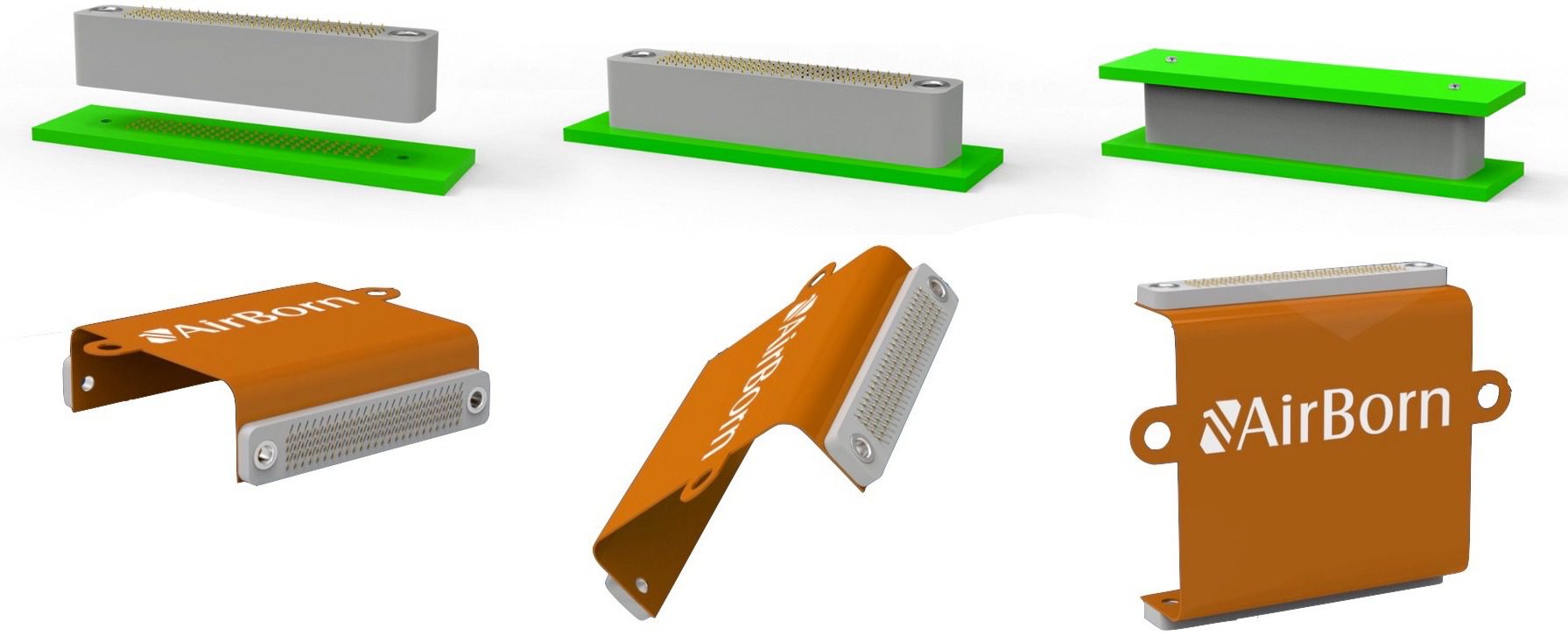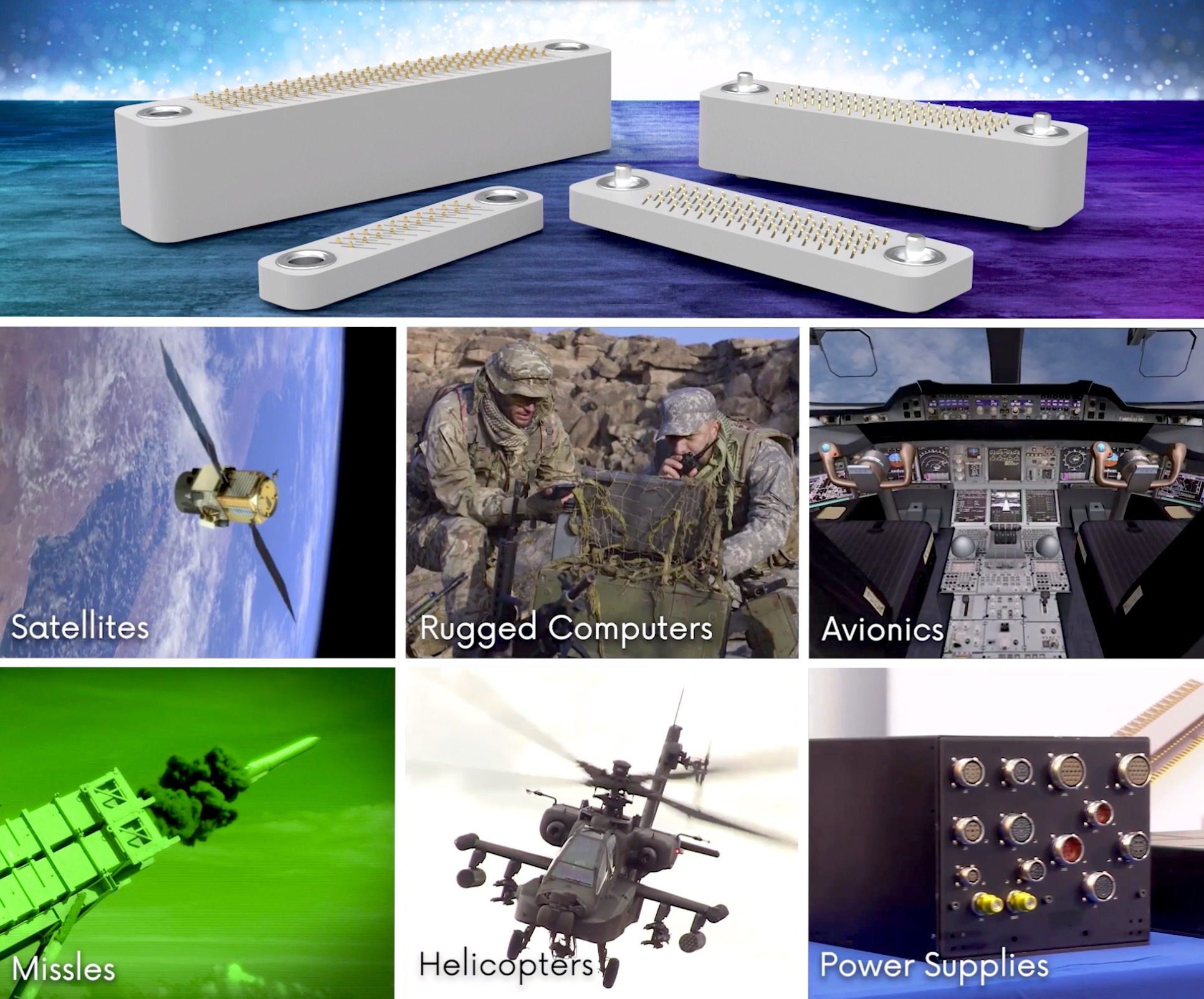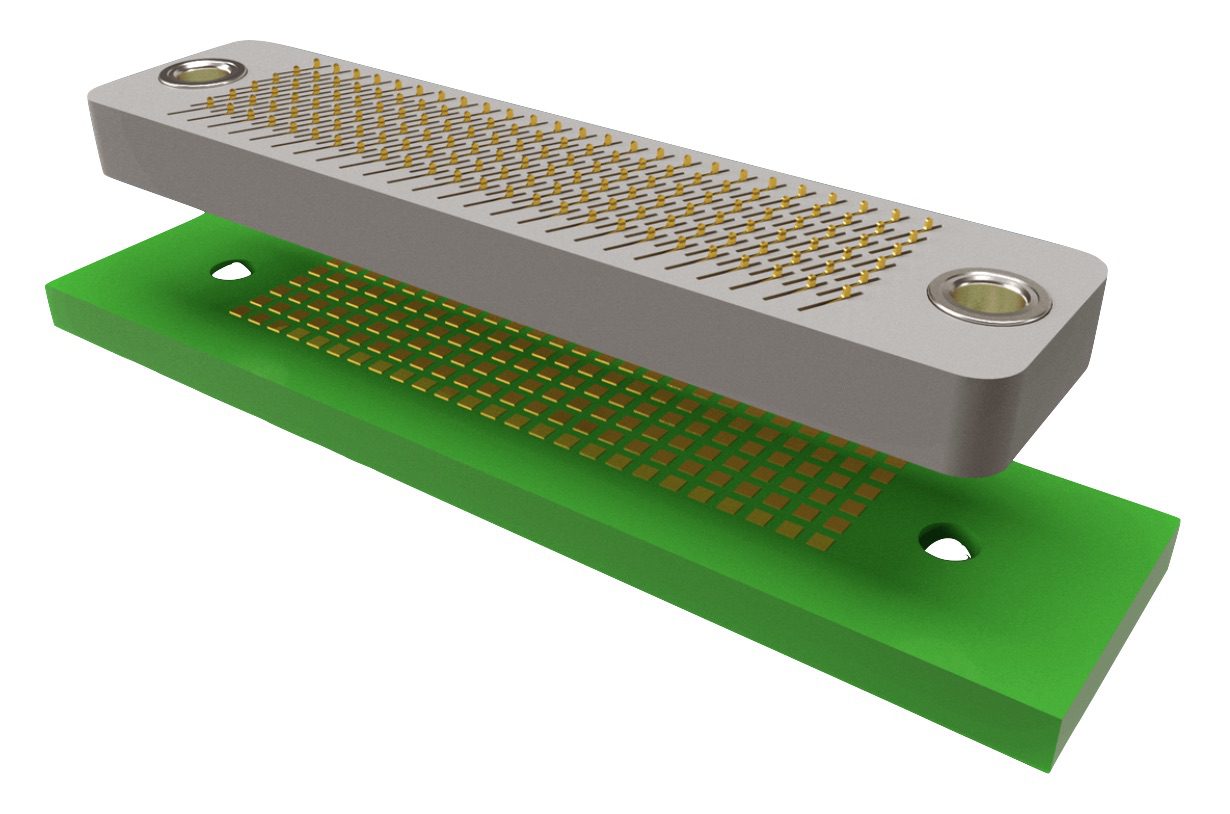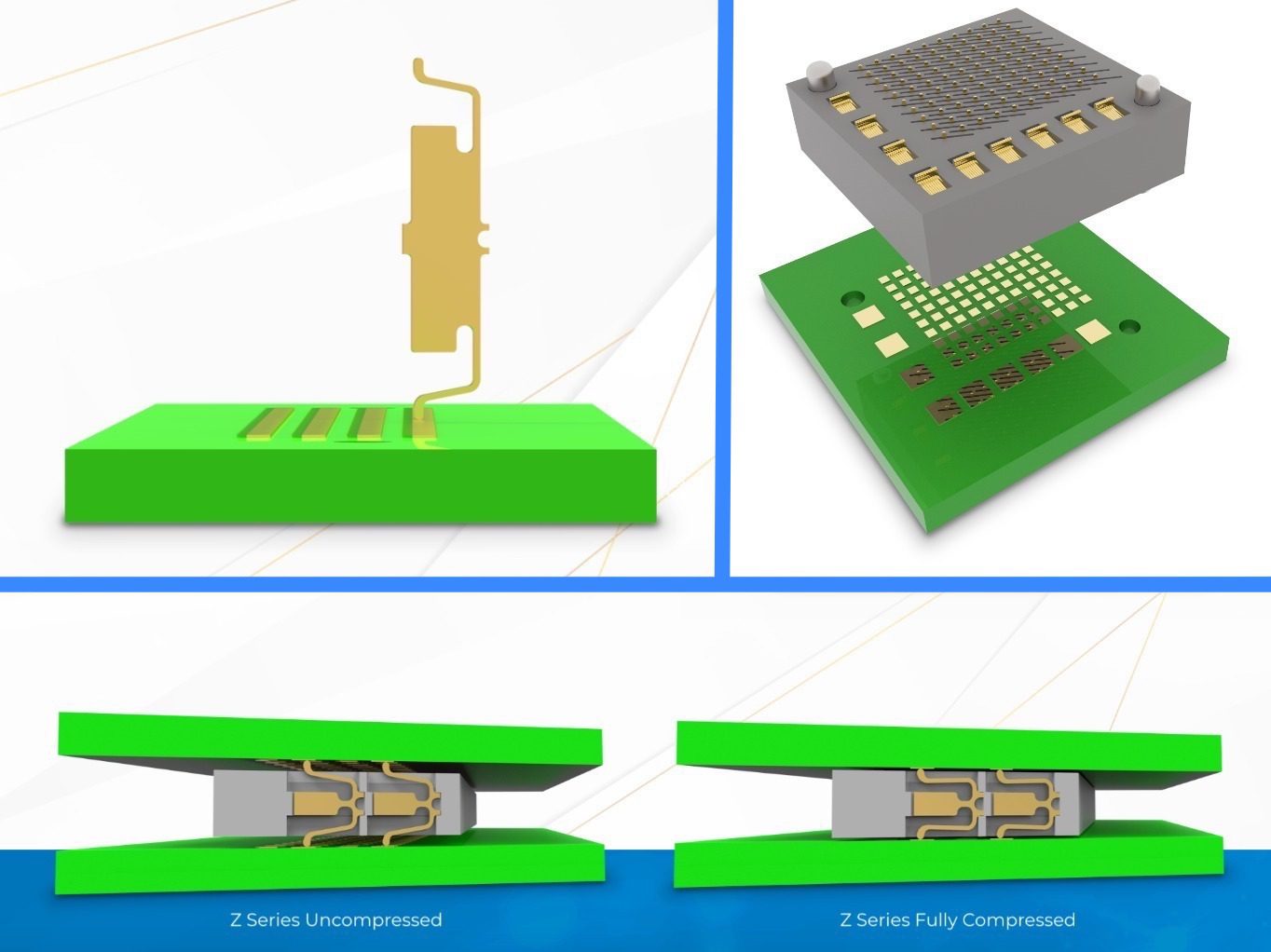Utilizing Solderless Compression Interposers in Harsh-Environment Applications
These interposers are a great alternative to traditional pin-and-socket interconnects in harsh-environment board-to-board or board-to-flex circuit applications.

For the vast majority of applications, the pin-and-socket interface remains the contact of choice. Pin-and-socket contacts can be found in just about every application imaginable. But there is another option that should be considered and, in some instances, may be the only option: solderless compression interposers.
Solderless Compression Interposers
Solderless compression interposers are ultra-low-profile connectors equipped with contacts that pass through the connector body to establish direct connections between two printed circuit boards (PCBs), or a PCB and a flexible circuit, and guide pins or hardware that align the contacts with the mating pads on the board.

AirBorn’s Z Series Solderless Compression Interposers aligned with target PCB pads (top left), attached to target PCB (top center), sandwiched between two PCBs (top right), and affixed to space-saving, 3-D routable flexible circuits (bottom row).
In addition, unlike connectors with surface-mount, plated-through-hole, or paste-in-hole contacts, solderless compression connectors don’t require any soldering. While this is extremely beneficial in terms of installation time and effort, it also means that solderless compression connectors establish impermanent connections with PCB pads, which, alone, has negative implications for reliability. But that’s where the compression part comes in. The contacts within solderless compression interposers are each equipped with integral or secondary spring members that exert sufficient, constant force on the PCB pads and effectively absorb and compensate for external forces, like shock and vibration, to maintain reliable connections.
There is a widespread misperception that solderless compression interposers are not as reliable as soldered connections in high-shock and -vibration environments. But it’s quite the contrary. Solderless interposers are inherently designed to flex and absorb movement caused by shock and vibration, and several leading connector suppliers have designed and developed solderless compression interposers tested and proven to perform as well as soldered connectors in even harsh environments. In fact, despite the misperception that has prevented some design engineers from considering solderless compression connectors, these interposers have been field-proven in high-reliability, harsh-environment applications including military attack helicopters, missiles, FLIR systems, satellites, space launch vehicles, avionics, and airborne radar systems.

AirBorn’s Z Series Solderless Compression Interposers have undergone extensive testing to the MIL-DTL-55302, MIL-DTL-83513, MIL-STD-202, and EIA 364 specifications and standards to verify their rugged, high-reliability performance in harsh-environment applications.
How Solderless Compression Interposers Differ From Other Connectors
Solderless compression interposers differ from traditional pin-and-socket connectors in two primary ways: the mating style and the termination method.
Traditional pin-and-socket connectors are made up of two mating connectors, a plug and a receptacle. Plugs either have socket contacts that mate to pin contacts in the receptacle, or vice versa. In contrast, solderless compression interposers don’t mate with other connectors; instead, they simply sit between two PCBs, making direct contact between the mating pads on both boards.
There are, however, two types of solderless compression interposers: dual-compression and single-compression. Dual-compression variants establish contact on both sides of the interposer, balancing the opposing compression forces, while single-compression variants establish contact on only one side of the interposer.

A dual-compression version of AirBorn’s Z Series Solderless Compression Interposers.
To terminate, the solderless contacts are simply compressed onto PCB pads on one or both sides of the interposer, and that’s it. No soldering required. This is one of the primary benefits of solderless compression interposers, as it eliminates any concerns or expenses associated with soldering, including cracked solder joints, precision placement equipment, X-ray inspection, and RoHS compliance concerns due to lead content contamination.
Press-fit connectors also support solderless termination but, unlike solderless compression interposers, generally establish permanent connections and don’t offer the same versatility in terms of removal and reinstallation. Solderless compression interposers, on the other hand, are designed to support impermanent installation, no-consequence unmating, and plug-and-play reinstallation, which makes maintenance and upgrades for applications such as joystick controls in large commercial aircraft fast, easy, and affordable.
Benefits of Solderless Compression Interposers
Additional benefits of solderless compression interposers include:
- Compatibility with extreme-density, board-to-board, or flex-to-board applications with pitches as tight as 0.4 mm.
- Alternatives for applications in which soldered connections are either not desirable or impossible.
- Tolerance compensation, which allows boards to be stacked on top of each other since the spring movement accommodates for tolerance stack-ups.
- Blind mating capabilities. Since no insertion is required and compression contacts self-correct for x, y, z, rotational, and angular target misalignment, there’s no risk of broken or bent pins or mismating.
- The ability to connect surfaces that are not perpendicular to the contact axis, which is especially advantageous in instances where slight board bowing could occur.
- Options for ultra-low-profile designs with profile heights of less than 2 mm.
- Short signal paths that ensure excellent signal integrity for both high-frequency analog and digital applications.
- Low, stable resistance.
- High-cycle lifetimes often only limited by the pad plating thickness, with typical durability ratings extending from 20,000 to 300,000 mating cycles for some types of interposers.
- Widespread compatibility with unique body styles and contact arrangements utilizing standard component form factors.
- Very lightweight, which is ideal for applications like military and commercial aircraft and drones.
- Single-connector solutions with no need for mating connectors, which shortens signal paths and reduces costs as well as potential points of failure.
- Support for land grid array (LGA) applications including microprocessors.
- Compatibility with flex circuit assemblies, which further eliminate the bulk associated with traditional mated pairs of connectors.
Types of Solderless Compression Interposers
Not all solderless compression interposers are equipped to deliver equivalent performance. The right version depends on the needs of the application, and versions differ by the type of contacts they employ. Options include fine-wire-spring contacts, spring-loaded contacts, ball-spring-loaded contacts, spring contacts, and compression contacts.
Fine-Wire-Spring Contacts: One of the earliest solderless interposer designs made use of fine-wire-spring contacts. Often referred to as Fuzz Buttons, a registered trademark of Custom Interconnects, fine-wire-spring contacts are constructed of gold-plated molybdenum or beryllium copper wire wound and compressed into a dense, sponge-like cylindrical shape with diameters ranging from a few tenths of a millimeter to a millimeter. These contacts have simple, single-piece designs that help lower costs and increase reliability, and they also offer the tightest pitch of the different interposer contact types. However, they don’t offer wiping action during engagement, which is critical for removing foreign object debris (FOD) or oxidization from mating pads, and they require careful handling since there is no retention mechanism to hold the contacts in place.
Spring-Loaded Contacts: Also known as spring-loaded pins, spring probes, or Pogo Pins, a registered trademark of Everett Charles Technologies (ECT), these solderless compression contacts are typically made up of several machined components, including internal helical springs that apply constant normal force against the back of the mating receptacle or contact plate. These springs are what gives spring-loaded compression contacts the unique ability to engage with any flat or concave metal surface, whether it’s incorporated within a mating interface or just a plated area of a PCB.
A typical spring-loaded pin consists of three main parts: a plunger or piston, a barrel, and a spring. When force is applied to these pins, the plunger compresses the spring within the barrel. These types of pins enable certain interposer designs that are not achievable using other connector solutions, are available for cable terminations, and are ideal for applications where the contacts will be exposed to the outside environment. However, each of the pieces that comprise these contacts adds another potential point of failure, with the most common failure mode being seized springs that prevent contact. In addition, these are often the most expensive option and, like fine-wire-spring contacts, also don’t wipe across the mating face during engagement to remove potential FOD or oxidization.
Ball-Spring-Loaded Contacts: A specific version of spring-loaded contacts, ball-spring-loaded contacts replace the traditional plunger with a ball that supports omnidirectional mating and are ideal for connections with a rotational feature, like twist-and-lock connectors. Due to their omnidirectional mating design, these contacts do perform wiping action on mating surfaces, just not as strongly or effectively as some other interposer types.
Spring Contacts: Spring contacts were some of the earliest compression contacts. These single-piece contacts have a literal spring form factor but generally incorporate either a braided spring or an elastic coil with the contact design. Spring contacts also tend not to deliver any lateral wiping movement across mating faces, and their geometry can be detrimental to signal integrity performance in high-speed and high-frequency applications.
Compression Contacts: More modern interposer designs have incorporated simple, single-piece compression contacts, which are designed to both leverage the most beneficial qualities and overcome the limitations of previous designs. Single-piece compression contacts simplify the design of spring-loaded contacts by incorporating integral spring members, which eliminates the multiple potential points of failure inherent to spring-loaded contacts and enables both very high contact densities and lower costs.
One of the most unique features of these contacts is their ability to be ganged up within the same slot in an interposer body. This can be done to create multiple points of contact for added redundancy in especially high-reliability, harsh-environment applications, or to increase the rated amperage of some contacts within the interposer.

AirBorn’s patented, single-piece compression contact system (top left) exhibits lower resistance than contacts comprised of multiple components. These contacts also support ganged configurations, in which multiple contacts are loaded within the same interposer contact slot. (Contact slots are pictured in the bottom row with just one contact in each). The Z Series Solderless Compression Interposer pictured here (top right) employs 0.5A contacts arranged for both signal and power but incorporates some ganged contact configurations to support higher currents.
Compression Contact Recommendations for Harsh-Environment Applications
The following table compares several key features of solderless compression interposers with various contact types.

Solderless compression interposers equipped with modern compression contacts are highly recommended for harsh-environment applications due to qualities including their simple, single-piece contact design with dual-compression capabilities, their ability to establish multiple points of contact in ganged configurations, and their proven ability to effectively absorb and compensate for movement caused by even high shock and vibration and deliver long service lives.
Visit AirBorn online to learn more.
Like this article? Check out our other Harsh Environment and High-Reliability articles, How to Specify, our Mil/Aero Market Page articles, and 2021 Article Archives.
Subscribe to our weekly e-newsletters, follow us on LinkedIn, Twitter, and Facebook, and check out our eBook archives for more applicable, expert-informed connectivity content.





